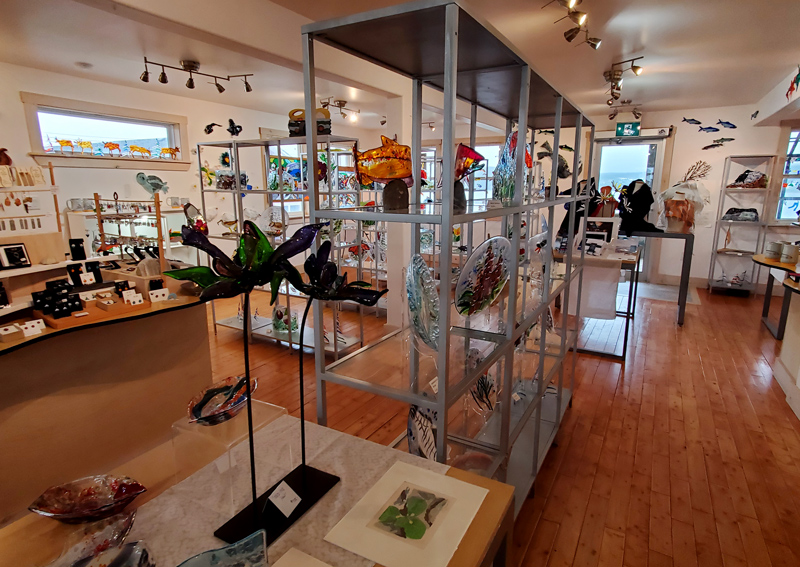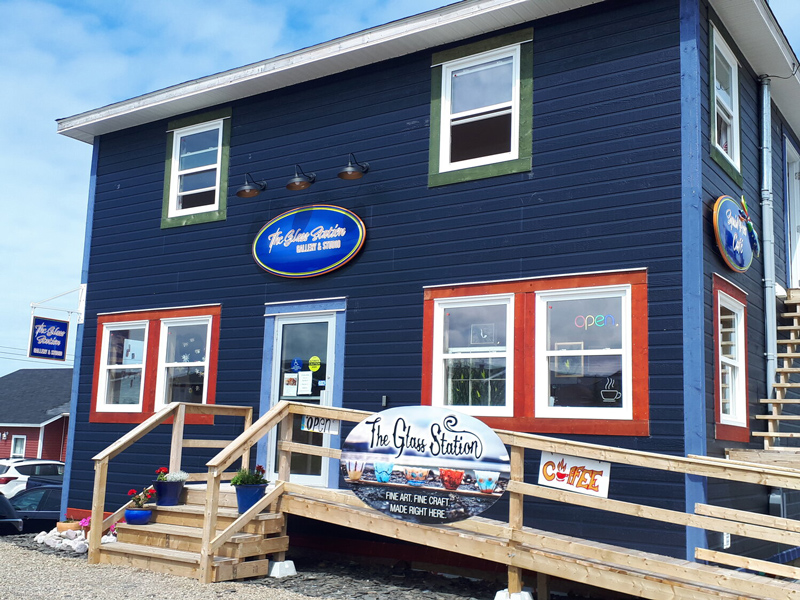Account Login
Don't have an account? Create One

People go into business for all sorts of reasons. For many artists in Atlantic Canada, including Urve Manuel, it came out of necessity, providing at least part of the income needed to make works of art possible.
Retail business? “It’s definitely not my forte, but in order to do what I want to do, I have to do it,” she said, in a recent interview with Atlantic Business Magazine.
Manuel is owner and operator of The Glass Station, a gallery/retail space and studio open in the Town of Rocky Harbour in Western Newfoundland since 2019. In addition to glass art she makes and offers for sale at the location, she personally selects and retails work from approximately 40 other fine art craftspeople. Her own studio workspace is just below the gallery, in the basement, packed with notes, sketches, more advanced designs and partially completed projects.
Atlantic Business Magazine reached out after The Glass Station was named Outstanding Retailer in the Atlantic Canada Craft Awards for Excellence in February. The award was presented at the Craft East Buyers’ Expo, in Halifax. Among other things, the expo is a place where people like Manuel can go to discover products possibly a fit for their retail enterprise. They can complete a wholesale order with the producer or, rarer for Manuel, consignment. The event is produced by Craft Alliance Atlantic, a regional trade association backed by provincial governments in the region and supported by craft organizations including Craft Nova Scotia, Craft N.B., the Cape Breton Centre for Craft & Design, New Brunswick College of Craft & Design, Craft Council of Newfoundland and Labrador, Anna Templeton Centre for Craft, Art & Design, Prince Edward Island Craft Council and Mawi’Art Collective. It’s also a good backdrop for the awards.
The recognition for The Glass Station — as a top retailer of craft work and particularly fine craft produced in the region — was meaningful, Manuel said. She was “delighted” by the acknowledgement. “I was surprised, but happily. I mean, that’s really… flattering. It’s an honour to get it because I know there are beautiful retail spaces across Atlantic Canada,” she told Atlantic Business Magazine.

As an artist, Manuel started on glass work after taking an evening class on traditional leaded glass, or what most of us might call stained glass. That was close to 20 years ago.
She decided to start a brick-and-mortar gallery business featuring her glass work only after years of working the circuit — packing and hauling glass pieces to small craft fairs, then larger fairs and exhibition events. The travel was an expensive time suck. But a more unique concern was the sheer amount of glass being moved over hundreds of kilometres, with high risk of damage.
“It was just too much all the time. So I wanted to find a space where people would come to me instead of me having to travel around the universe to display my work and try to make sales,” Manuel said (though she will still make the occasional trip).
The Glass Station’s name actually came from its original location. It was in a “moldy, leaky” former gas station in town, Manuel recalls, that happened to be an available space when she was looking to set up and get started, meeting the summer tourism rush. The population in Rocky Harbour, a town of about 950 people, balloons every summer, often with a healthy shoulder season, numbers petering out into winter.
“People would walk in and go, ‘Whoa, this kind of looks like a kitchen.’ I’m like, ‘That is my kitchen,’” she said, recalling how product covering the countertops would have to be moved each night to allow room for prepping and cooking dinner.
The business wasn’t entirely put together in time that first year but, as in every year since, Manuel made hay while the sun shined (and even on days when it didn’t), working long hours, seven days a week.
It was a successful start overall, she recalls, but the business wasn’t running long before the town became involved in a repair and renovation project one summer to try and improve the old building. So Manuel moved her business into her home. That summer, she moved a bed into the shed, to open up more floor space inside the house.
“People would walk in and go, ‘Whoa, this kind of looks like a kitchen.’ I’m like, ‘That is my kitchen,’” she said, recalling how product covering the countertops would have to be moved each night to allow room for prepping and cooking dinner.
Thinking about what would come next, she decided the retail enterprise was going to make its next home in a fresh build, purpose-built right on the water. But after all the hurdles to bring it into reality, after moving in, that wasn’t the end of the story.
“I tried to have a little café for three or four years, because I’ve got a beautiful patio that we built on the second year (…) But in order to have a café, you kind of need more than just baked goods and you need more staff. And, you know what? You can’t get staff,” she lamented.

Still, there were many good days. For the café, she was able to hire a woman locally who tackled baking, she found summer students to help here and there. That said, she still found — in the discovery of a rural business owner seeking new income opportunities and finding unexpected hurdles — she was still too often left pouring espressos and cleaning, torn away from the gallery.
“We ended up building two short-term rentals on the top floor to help with the mortgage,” Manuel said. That tacked on even more to the daily to-dos, in cleaning and managing bookings for the rentals.
“All of a sudden (with) this one job of just having my gallery and studio I have far too many. But whatever,” she said, steely. “That’s the way it goes.”
In the rural setting that has also inspired some of her art, Manuel has become tempered through direct experience. Apart from practical demands for the different lines of business, she’s settled details specific to the gallery. In selecting stock and pricing, as an example, she makes a point for instance not to offer products from Molly White’s Molly Made Fibre Art Studio in Woody Point. The island isn’t awash with fine art galleries, but Molly Made is not geographically too far away, as it’s also located in a community within Gros Morne National Park. Rather than compete with Molly Made, Manuel will tend not to stock up on, say, rug hooking materials or fibre art. In return, her glass work tends not to appear across the way, she said.

Manuel’s art is in private and public collections. In recent years, she has usually been offered one or two commission pieces a year. In Western Newfoundland, for example, she has an installation at Corner Brook City Hall. At the Deer Lake Regional Airport, about 45 minutes east of Corner Brook, “Coming and Going,” her installation of fish forms made with kiln-formed glass, glass enamel, copper and aluminum remains a landmark from an earlier time in her career.
“This year I haven’t had any (commissions) really. Again, it’s a sign of the times, I think,” she said, early in the “Year of the Arts” in Newfoundland and Labrador.
The timing on large-scale commissions can be a challenge, often having to be secured for Manuel ahead of winter, planned for when the tourists depart and she can spend more time in studio.
Still, the glass art is also more than just work for Manuel. Even without a grant guaranteed or an active commission, atop the demands of her businesses, she has pushed to isolate time for more ambitious creative efforts. She’s tackled “bucket list” projects at times, even if it means stretching her days and her finances to make it possible.
In 2022, she drew a wave of media attention and sparked public conversations in Newfoundland and Labrador with a large installation: a structure reminiscent of an ice fishing shack, with a metal frame set with panels of glass work. It was a project she’d long thought about and, even without supporting grants, she felt a deep desire to take on. Investing at least $10,000 into the project, she completed all of the required pieces and oversaw its careful set up at multiple locations around the island, before it was all brought to the main art gallery at The Rooms provincial cultural centre in St. John’s. It could be viewed there from September 2023 to the start of the new year.
“That’s sort of the work I would like to do, but no one’s going to buy it. People would love to have it. But basically, where would you put it? How would you keep it? Who’s going to pay? (…) (But) I would like to do more of my little sort of dream projects,” she said, really giving voice to the thought of many artists in Atlantic Canada.
Related Stories:
Comment policy
Comments are moderated to ensure thoughtful and respectful conversations. First and last names will appear with each submission; anonymous comments and pseudonyms will not be permitted.
By submitting a comment, you accept that Atlantic Business Magazine has the right to reproduce and publish that comment in whole or in part, in any manner it chooses. Publication of a comment does not constitute endorsement of that comment. We reserve the right to close comments at any time.
Cancel